# Bicycles, Mopeds, and Cars: Uncovering Efficiency in Travel
Written on
Chapter 1: An Unexpected Journey
In the realm of fuel efficiency, two wheels prove to be superior. The most efficient option might just surprise you.
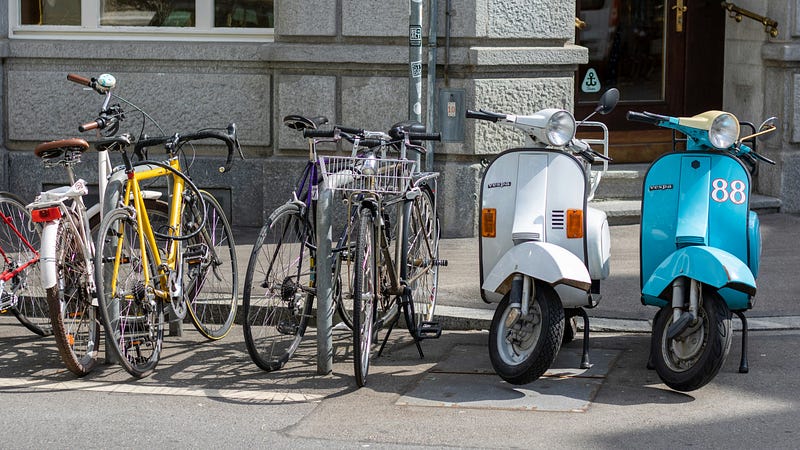
Last year, I embarked on a 200-mile (320 km) biking adventure from Seattle to Portland over the course of two days. My nutrition consisted of a continuous stream of snacks: granola and bagels for breakfast, chips and cookies for hourly breaks, and hamburgers for lunch. After a hearty spaghetti dinner, I woke up to waffles and bacon. After another day of indulging in Cheez Whiz straight from the can and M&Ms in gas station parking lots, I crossed the finish line and celebrated with bratwurst and a giant pretzel.

Upon returning home, I devoured an entire pizza—by myself. In total, I consumed around 10,000 calories over the two days. For comparison, that mountain of food contained less energy than half a gallon of gasoline. If I wished to continue my journey to Boise, I could have powered through with just a "gallon" of calories.
In a previous piece, I illustrated that runners can cover more than ten times the distance of a car with an equivalent amount of fuel:
Marathons Per Gallon: Can We Run More Efficiently than Our Cars?
A look at the energy consumption of gas-powered vehicles compared to food-powered human joggers.
This prior analysis overlooked some highly efficient vehicles: two-wheelers. Here, we will compare gas-powered and human-powered bicycles to identify the most efficient travel method.
The Vehicles
Motorcycles are often recognized for their fuel efficiency, yet a standard Harley typically achieves only around 50 miles per gallon (MPG), which is outperformed by a Prius. With hybrid vehicles raising the bar, motorcycles struggle to keep pace.
For a fair matchup, we should consider commuter-friendly mopeds or scooters like the Yamaha 2017 Vino Classic. With its lightweight build and small engine, this moped is touted as the most efficient gas-powered vehicle available. The Yamaha claims an impressive 127 MPG, though skepticism exists regarding the gap between advertised and actual mileage—a common joke among moped enthusiasts. However, for our analysis—free of life-or-death stakes—I will accept the manufacturer's claim that a moped can travel 127 miles on a gallon of gas (54 km/L).
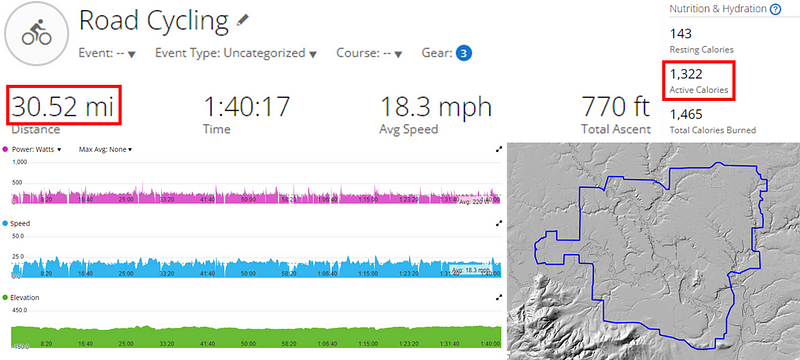
To assess the bicycle's efficiency, I rode approximately 30 miles (48 km) while using a fitness tracker. The route was flat and low-traffic on a calm day. Riding solo meant no drafting, which can improve efficiency by up to 40%. For this comparison, I equated 29,000 food calories to one gallon of gas.
The Results
As expected, the bicycle outperforms the moped in terms of distance traveled on food versus gasoline. Engines simply cannot convert energy into propulsion as effectively as the human body.
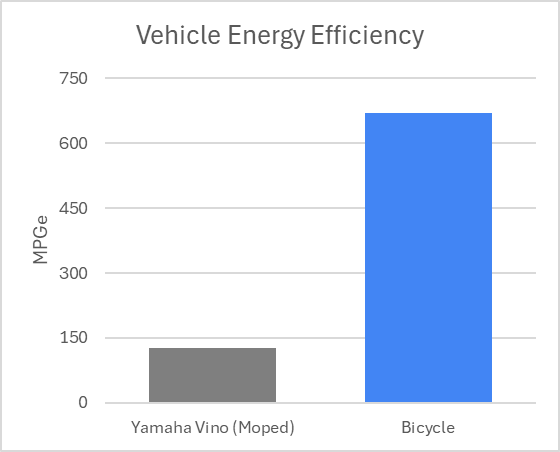
However, examining two-wheeled vehicles against each other reveals an even more compelling narrative. Both significantly surpass four-wheeled alternatives. A good moped easily outdistances an average gas car and can even outpace a Tesla Model Y using equivalent electrical energy (1 gallon = 33.7 kWh).
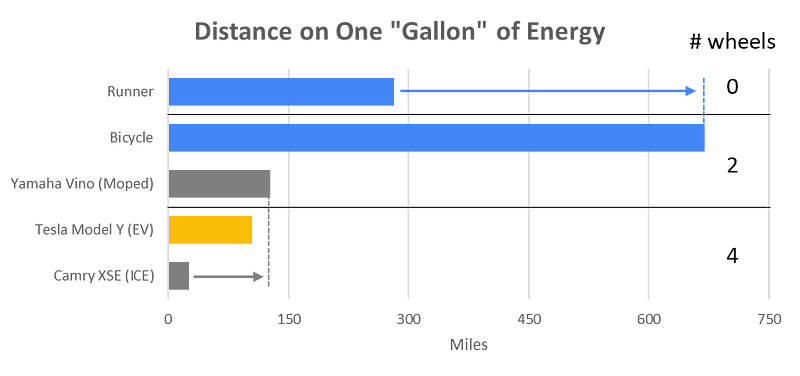
Two-wheeled vehicles consistently excel, irrespective of the fuel type, residing within an optimal efficiency zone characterized by low drag and high momentum. The excessive weight and size of cars adversely affect their fuel efficiency.
However, human limitations exist: we cannot spin our legs indefinitely, and our maximum speed is restricted. Humans generally operate in a single gear, making sustained high speeds energy-intensive.
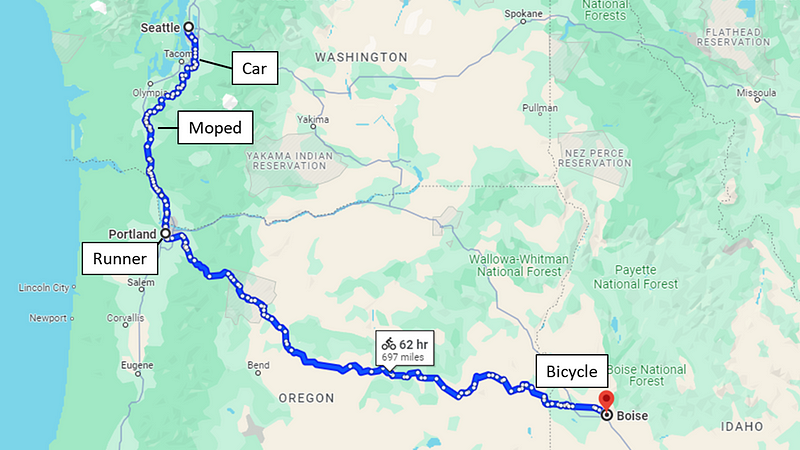
If a car, moped, ultramarathon runner, and cyclist each start from the Space Needle with either one gallon of gas or the nutritional equivalent of 29,000 calories, the results are telling. The car runs out of fuel in the Seattle suburbs, the moped sputters to a stop halfway to Portland, the runner makes it to Portland but not beyond, while the bicycle is the only vehicle to complete the journey.
Should we consider two-wheeled vehicles more often?
This analysis serves to highlight the energy required for everyday activities, such as driving to the store. While I do not advocate for a complete lifestyle overhaul, the data suggests that biking could be a more viable option.
It's essential to remember a few caveats. Most households still rely on cars, and while I cycle whenever possible, my biking habits have little effect on my overall car usage.
When deciding how to travel, efficiency is merely one of many factors. Practical considerations such as cargo and distance also play a role. While I can carry 50 lbs of groceries for 20 miles on a bicycle, transporting a family of four over 200 miles is impractical on two wheels. In contrast, cars can handle additional cargo and passengers with less impact on fuel efficiency.
That said, if you're running a short errand without much to carry and the weather permits, consider hopping on a bike. Any kind of bike—be it motorized, electric, or pedal—will suffice. Ultimately, two wheels are indeed the optimal choice.
Are you curious about e-bikes?
So am I! They potentially achieve over 1000 MPGe (400 km/L), making them the most efficient vehicles available. However, I'd prefer to verify this through testing. A comprehensive assessment should factor in both electrical energy and food calories.
If I can evaluate an e-bike using a fitness tracker and an outlet wattmeter, I’ll provide a more definitive update.
Chapter 2: Efficiency Showdown
The first video titled Car Vs Bike: Which Is More Efficient | GCN Fuel Economy Challenge! explores the efficiency comparisons between cars and bikes, revealing surprising insights.
The second video titled Scooter vs Bike: Which is the Best Mode of Transportation for You? delves into the pros and cons of scooters and bikes as transportation choices, helping viewers make informed decisions.